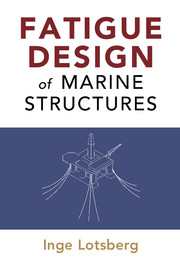Refine listing
Actions for selected content:
1211 results in Ebooks in petroleum sciences
3 - Fatigue Design Approaches
-
- Book:
- Fatigue Design of Marine Structures
- Published online:
- 05 March 2016
- Print publication:
- 13 April 2016, pp 95-122
-
- Chapter
- Export citation
10 - Fatigue Assessment Based on Stress Range Distributions
-
- Book:
- Fatigue Design of Marine Structures
- Published online:
- 05 March 2016
- Print publication:
- 13 April 2016, pp 310-326
-
- Chapter
- Export citation
17 - Fatigue of Grouted Connections
-
- Book:
- Fatigue Design of Marine Structures
- Published online:
- 05 March 2016
- Print publication:
- 13 April 2016, pp 435-464
-
- Chapter
- Export citation
6 - Stress Concentration Factors for Tubular and Shell Structures Subjected to Axial Loads
-
- Book:
- Fatigue Design of Marine Structures
- Published online:
- 05 March 2016
- Print publication:
- 13 April 2016, pp 205-230
-
- Chapter
- Export citation
References
-
- Book:
- Fatigue Design of Marine Structures
- Published online:
- 05 March 2016
- Print publication:
- 13 April 2016, pp 499-520
-
- Chapter
- Export citation
APPENDIX B - Stress Intensity Factors
-
- Book:
- Fatigue Design of Marine Structures
- Published online:
- 05 March 2016
- Print publication:
- 13 April 2016, pp 494-498
-
- Chapter
- Export citation
Index
-
- Book:
- Fatigue Design of Marine Structures
- Published online:
- 05 March 2016
- Print publication:
- 13 April 2016, pp 521-535
-
- Chapter
- Export citation
Contents
-
- Book:
- Fatigue Design of Marine Structures
- Published online:
- 05 March 2016
- Print publication:
- 13 April 2016, pp v-xvi
-
- Chapter
- Export citation

Rifts and Passive Margins
- Structural Architecture, Thermal Regimes, and Petroleum Systems
-
- Published online:
- 05 March 2016
- Print publication:
- 02 March 2016

Fatigue Design of Marine Structures
-
- Published online:
- 05 March 2016
- Print publication:
- 13 April 2016
4 - Determination of timing of rift and continental breakup events
-
- Book:
- Rifts and Passive Margins
- Published online:
- 05 March 2016
- Print publication:
- 02 March 2016, pp 97-121
-
- Chapter
- Export citation
20 - Hydrocarbon Preservation
-
- Book:
- Rifts and Passive Margins
- Published online:
- 05 March 2016
- Print publication:
- 02 March 2016, pp 505-506
-
- Chapter
- Export citation
References
-
- Book:
- Rifts and Passive Margins
- Published online:
- 05 March 2016
- Print publication:
- 02 March 2016, pp 507-593
-
- Chapter
- Export citation
15 - Models of source rock distribution, maturation, and expulsion in rift and passive margin settings
-
- Book:
- Rifts and Passive Margins
- Published online:
- 05 March 2016
- Print publication:
- 02 March 2016, pp 347-375
-
- Chapter
- Export citation
16 - Models of reservoir quality distribution
-
- Book:
- Rifts and Passive Margins
- Published online:
- 05 March 2016
- Print publication:
- 02 March 2016, pp 376-413
-
- Chapter
- Export citation
11 - The role of syn-rift deposition and erosion in thermal regimes of rifts and passive margins
-
- Book:
- Rifts and Passive Margins
- Published online:
- 05 March 2016
- Print publication:
- 02 March 2016, pp 273-293
-
- Chapter
- Export citation
Contents
-
- Book:
- Rifts and Passive Margins
- Published online:
- 05 March 2016
- Print publication:
- 02 March 2016, pp vii-viii
-
- Chapter
- Export citation
17 - Sealing characteristics
-
- Book:
- Rifts and Passive Margins
- Published online:
- 05 March 2016
- Print publication:
- 02 March 2016, pp 414-441
-
- Chapter
- Export citation
3 - Determination of unstretched continental, thinned continental, proto-oceanic, and oceanic crustal boundaries
-
- Book:
- Rifts and Passive Margins
- Published online:
- 05 March 2016
- Print publication:
- 02 March 2016, pp 76-96
-
- Chapter
- Export citation
5 - The role of lithospheric composition and compositional variations in evolving rift margin architectural development and in breakup locations
-
- Book:
- Rifts and Passive Margins
- Published online:
- 05 March 2016
- Print publication:
- 02 March 2016, pp 122-145
-
- Chapter
- Export citation
